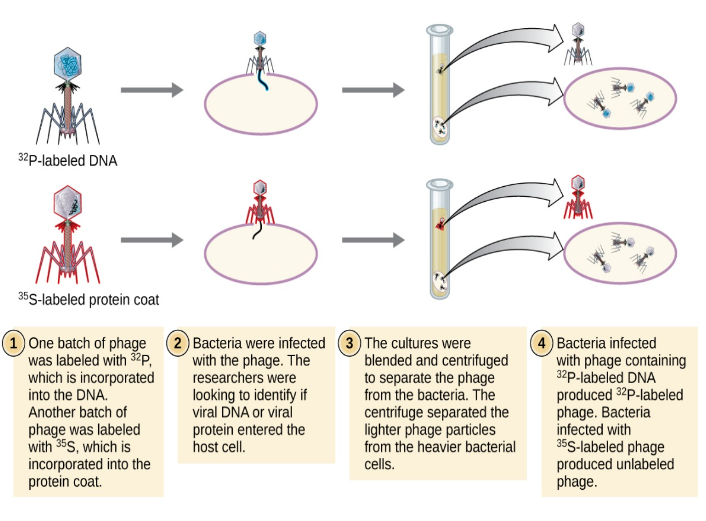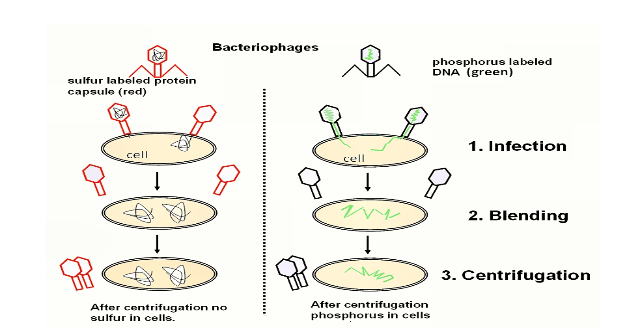
Answer
419.7k+ views
Hint: An experiment in bacteria with radioactively labeled viruses was done by Alfred Harshey and Martha Chase in 1952. Their experiment was totally based upon the biology of a virus known as bacteriophage T2, this virus attacks bacteria. The virus contains either DNA or RNA as their genetic material along with protein. DNA is packed inside a coat of protein.
Complete answer:
- With the help of the search of genetic material for an inheritance, Frederick Griffith concluded that one strain of bacteria was physically transformed by the heat-killed another strain of bacteria by transferring some transforming principle. The transforming principle was the genetic material.
- Alfred Harshey and Martha Chase in 1952 worked on viruses that infected bacteria called bacteriophages, to prove that the DNA is the genetic material.
- When bacteriophage is attached to the surface of bacteria, its genetic material is transferred into the bacterial cell. Bacteria treat the genetic material of a virus as its own genetic material and bacteria manufacture more viruses.
- Hershey and Chase worked to discover that the genetic material that enters the bacteria from the virus was protein or DNA.
- Two batches of viruses were grown by them, one with radioactive phosphorus which is found in DNA, and another with radioactive sulfur which is found in DNA.
- A virus that contained radioactive DNA showed radioactivity and infected bacteria whereas the bacteria infected with viruses that contained radioactive protein did not show radioactivity and indicates that viral DNA was passed to infected bacteria.
- Radioactivity was not lost by metabolic activity.


Hence, the correct answer is option (D).
Note: Hershey and Chase worked on the same but longer-term experiments. They allowed the offsprings of viruses to multiply in unlabeled bacteria. When the results were observed viruses contained almost no 35S and parental viral protein was absent. They contain one-third of the original 32P and hence one-third of the original DNA was present. This is because DNA is passed from generation to generation, not protein as the DNA contains the hereditary information and protein does not have such function.
Complete answer:
- With the help of the search of genetic material for an inheritance, Frederick Griffith concluded that one strain of bacteria was physically transformed by the heat-killed another strain of bacteria by transferring some transforming principle. The transforming principle was the genetic material.
- Alfred Harshey and Martha Chase in 1952 worked on viruses that infected bacteria called bacteriophages, to prove that the DNA is the genetic material.
- When bacteriophage is attached to the surface of bacteria, its genetic material is transferred into the bacterial cell. Bacteria treat the genetic material of a virus as its own genetic material and bacteria manufacture more viruses.
- Hershey and Chase worked to discover that the genetic material that enters the bacteria from the virus was protein or DNA.
- Two batches of viruses were grown by them, one with radioactive phosphorus which is found in DNA, and another with radioactive sulfur which is found in DNA.
- A virus that contained radioactive DNA showed radioactivity and infected bacteria whereas the bacteria infected with viruses that contained radioactive protein did not show radioactivity and indicates that viral DNA was passed to infected bacteria.
- Radioactivity was not lost by metabolic activity.


Hence, the correct answer is option (D).
Note: Hershey and Chase worked on the same but longer-term experiments. They allowed the offsprings of viruses to multiply in unlabeled bacteria. When the results were observed viruses contained almost no 35S and parental viral protein was absent. They contain one-third of the original 32P and hence one-third of the original DNA was present. This is because DNA is passed from generation to generation, not protein as the DNA contains the hereditary information and protein does not have such function.
Recently Updated Pages
How many sigma and pi bonds are present in HCequiv class 11 chemistry CBSE

Mark and label the given geoinformation on the outline class 11 social science CBSE

When people say No pun intended what does that mea class 8 english CBSE

Name the states which share their boundary with Indias class 9 social science CBSE

Give an account of the Northern Plains of India class 9 social science CBSE

Change the following sentences into negative and interrogative class 10 english CBSE

Trending doubts
A group of fish is known as class 7 english CBSE

The highest dam in India is A Bhakra dam B Tehri dam class 10 social science CBSE

Write all prime numbers between 80 and 100 class 8 maths CBSE

Fill the blanks with the suitable prepositions 1 The class 9 english CBSE

Onam is the main festival of which state A Karnataka class 7 social science CBSE

Who administers the oath of office to the President class 10 social science CBSE

Differentiate between homogeneous and heterogeneous class 12 chemistry CBSE

Kolkata port is situated on the banks of river A Ganga class 9 social science CBSE

Difference between Prokaryotic cell and Eukaryotic class 11 biology CBSE



